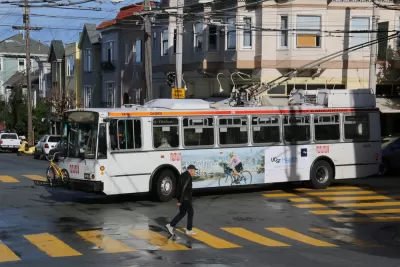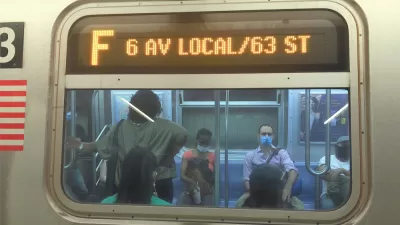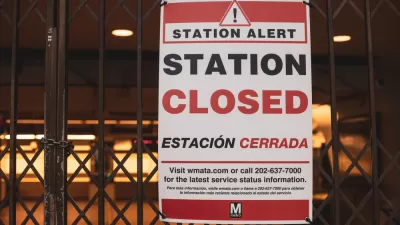Advocates have been waiting for the other shoe to drop as transit agencies deal with cratered revenues during the pandemic without support from Congress.

Carly Graf reports from San Francisco, where San Francisco Municipal Transportation Authority (SFMTA) officials recently released figures forecasting layoffs for as many as 1,226 full-time employees.
The layoffs would require SFMTA to reduce operations below the system's current 30 percent reduction in service during the pandemic.
Graf provides details on just how complete the fiscal crisis has become: "With farebox revenue still down by roughly 93 percent, parking revenue plateauing at roughly 50 percent of pre-pandemic levels and reductions to the agency’s General Fund contribution and sales tax revenues, funding through the traditional channels is unlikely to move the needle enough to close the gap."
SFMTA Director of Transportation Jeffrey Tumlin is quoted in the article issuing dire warnings and a bit of perspective, saying that the fiscal crisis is now far worse than the worst-case scenarios imagined at the beginning of the pandemic.
In Washington, D.C., Washington Metropolitan Area Transit Authority (WMATA) officials are detailing similar deep cuts to employment and service, piling on to news that first broke earlier in November. Jordan Pascale reports that the WMATA is now proposing that weekend service be eliminated entirely as that agency struggles to close a $500 million gap. "The plan also calls for trains to run every 30 minutes, shuttering 19 stations, further slashing bus service to a fraction of pre-pandemic levels and closing the system at 9 p.m," according Pascale.
New York City announced similarly massive layoffs and service reductions—a 40 percent reduction in weekday subway service and 9,000 layoffs—midway through November. Denver announced similar plans in September, as did the Maryland Department of Transportation.
News broke today about a potential $908 billion stimulus plan advancing in the U.S. Senate, though early reporting by Seung Min Kim, Jeff Stein, and Mike DeBonis on the news lacks details about how much of the package will be spent to rescue the nation's public transit agencies. The Riders Alliance, however, took to Twitter to oppose the bill as inadequate to the scale of the fiscal crisis facing transit in the United States. Jeff Stein also Tweeted a breakdown of spending included in the bill, with a document that identifies $45 billion for transportation, a figure that include airports, airlines, private bus companies, and Amtrak in its total, in addition to public transit.
FULL STORY: SFMTA prepares for massive potential layoffs as budget crisis continues to build

Alabama: Trump Terminates Settlements for Black Communities Harmed By Raw Sewage
Trump deemed the landmark civil rights agreement “illegal DEI and environmental justice policy.”

Planetizen Federal Action Tracker
A weekly monitor of how Trump’s orders and actions are impacting planners and planning in America.

Why Should We Subsidize Public Transportation?
Many public transit agencies face financial stress due to rising costs, declining fare revenue, and declining subsidies. Transit advocates must provide a strong business case for increasing public transit funding.

‘Clybourne Park’ Sets Stage for Housing Equity Discussions
Clybourne Park, a play exploring race, real estate, and community tensions, can set the stage for discussion on the lasting impacts of housing discrimination, gentrification, and the fight for affordability.

Understanding Road Diets
An explainer from Momentum highlights the advantages of reducing vehicle lanes in favor of more bike, transit, and pedestrian infrastructure.

New California Law Regulates Warehouse Pollution
A new law tightens building and emissions regulations for large distribution warehouses to mitigate air pollution and traffic in surrounding communities.
Urban Design for Planners 1: Software Tools
This six-course series explores essential urban design concepts using open source software and equips planners with the tools they need to participate fully in the urban design process.
Planning for Universal Design
Learn the tools for implementing Universal Design in planning regulations.
Caltrans
Smith Gee Studio
Institute for Housing and Urban Development Studies (IHS)
City of Grandview
Harvard GSD Executive Education
Toledo-Lucas County Plan Commissions
Salt Lake City
NYU Wagner Graduate School of Public Service




























